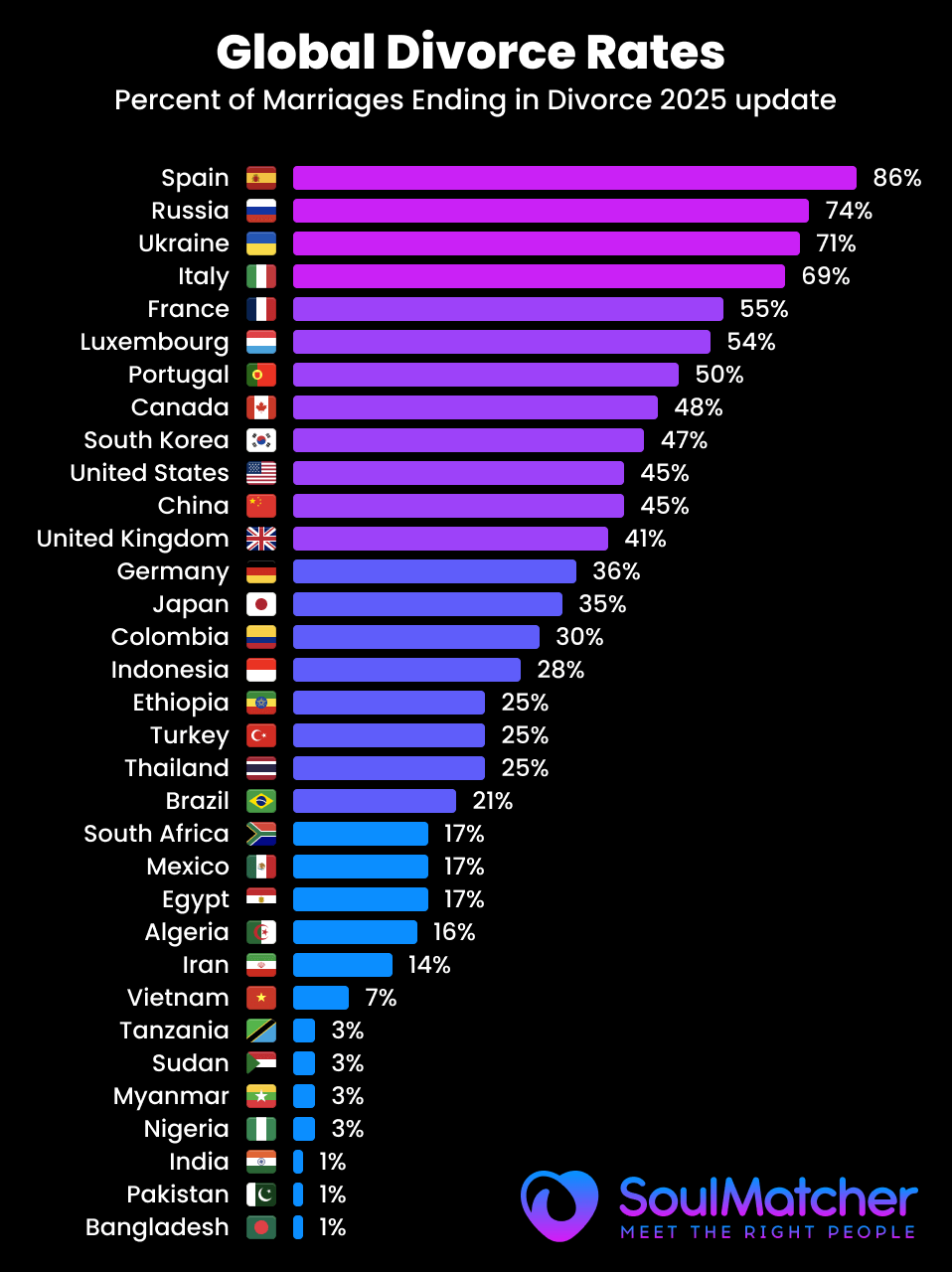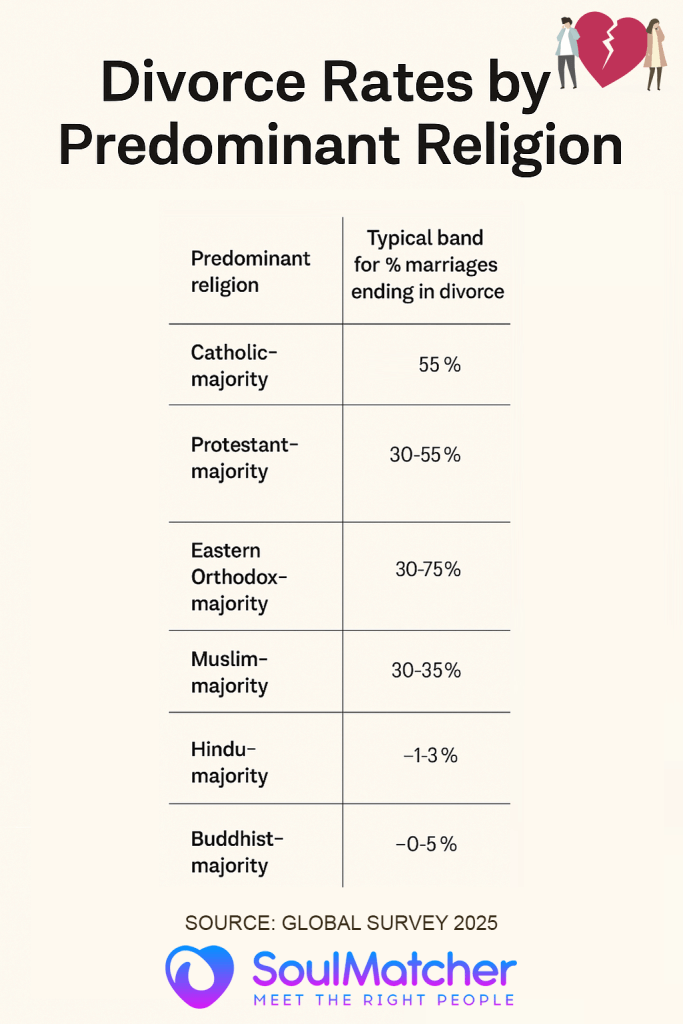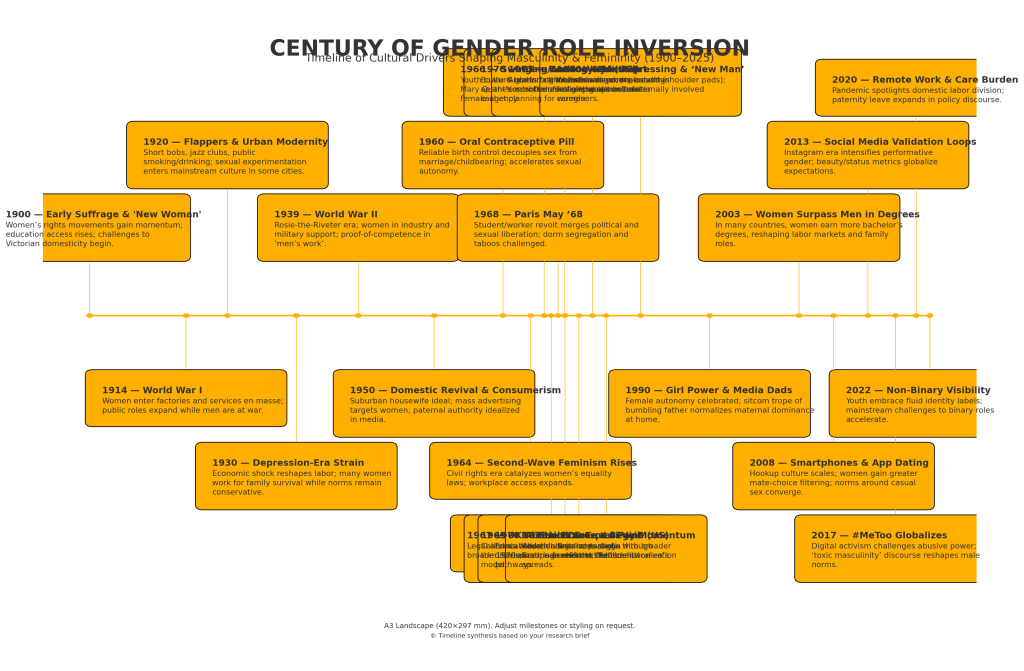소개 및 주요 지표
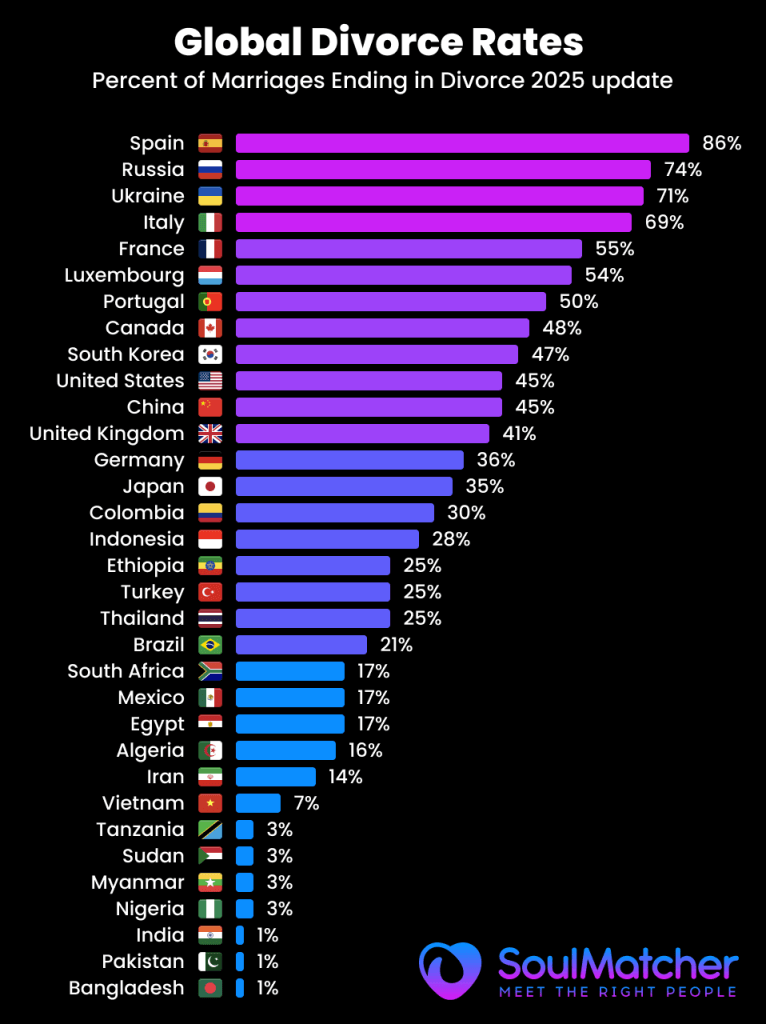
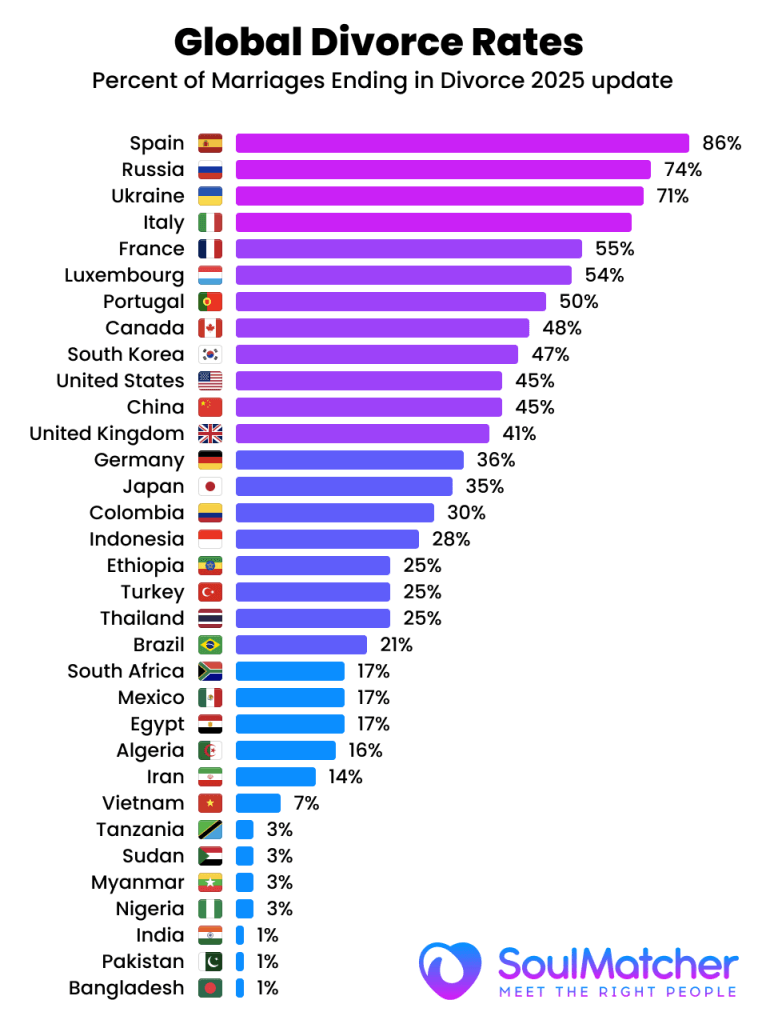
이혼은 지난 수십 년 동안 전 세계적으로 점점 더 보편화되었지만, 국가와 지역에 따라 그 추세는 크게 다릅니다. 전 세계적으로 조 이혼율(인구 1,000명당 연간 이혼 건수)은 1970년대부터 2000년대까지 약 두 배로 증가했습니다. 예를 들어, 유럽 연합의 경우 이혼율이 1970년에서 2000년에 1964년 인구 1,000명당 0.8명 에 2023년 1,000명당 2.0명같은 기간 동안 혼인율이 501% 감소했음에도 불구하고 이혼율은 오히려 증가했습니다. 그러나 이혼 패턴은 각 국가의 사회적 규범, 법적 체계, 인구통계학적 추세를 반영하기 때문에 획일적이지 않습니다. 이혼을 측정하는 두 가지 주요 방법은 다음과 같습니다:
- 조잡한 이혼율: 특정 연도의 인구 1,000명당 이혼 건수입니다. 이는 인구의 연간 이혼 빈도를 나타냅니다.
- 이혼 대 결혼 비율(이혼 비율): 결혼 건수 대비 이혼 건수를 백분율로 표시합니다(예: 결혼 100건당 이혼 건수). 이렇게 하면 대략적인 평생 위험 결혼이 결국 이혼으로 끝날 확률이 높다는 것을 의미합니다. 예를 들어 50%의 비율은 결혼의 약 절반이 이혼으로 끝나는 것을 의미합니다.
이러한 지표를 맥락에 맞게 해석하는 것이 중요합니다. 이혼율은 미혼 인구 비율이나 연령 구조에 따라 영향을 받을 수 있습니다. 이혼율은 평생 이혼 위험에 대한 대략적인 추정치로, 현재의 결혼 및 이혼 패턴이 일정하다고 가정하지만 실제 평생 이혼율은 시간에 따른 결혼 코호트를 추적하여 계산됩니다. 그럼에도 불구하고 이러한 지표를 종합하면 이혼 유병률에 대한 유용한 그림을 얻을 수 있습니다.
국가별 이혼 통계(최신 데이터)
아래 표에는 가장 최근 연도의 데이터, 조 이혼율, 조 혼인율, 이혼으로 끝나는 결혼의 추정 비율(이혼 대 혼인 비율) 등 신뢰할 수 있는 데이터가 있는 국가의 이혼율이 나와 있습니다. 이를 통해 이혼 유병률에 대한 국가별 분석을 제공합니다.
유럽
유럽은 세계에서 이혼율이 가장 높은 국가 중 하나입니다. 많은 유럽 및 구소련 국가들은 20세기 후반에 이혼이 급증했으며, 현재 결혼의 40~90%가 이혼으로 끝납니다. 반면 최근에야 이혼을 합법화하거나 정상화한 몇몇 유럽 국가에서는 이혼율이 훨씬 낮은 것으로 나타났습니다.
| 국가 | 데이터 연도 | 인구 1,000명당 이혼 건수 | 1,000명당 결혼 건수 | 이혼으로 끝나는 결혼의 % |
|---|---|---|---|---|
| 스페인 | 2020 | 1.6 | 1.9 | 84.2% (세계 최고 수준) |
| 러시아 | 2020 | 3.9 | 5.3 | 73.6% |
| 우크라이나 | 2020 | 2.9 | 4.1 | 70.9% |
| 프랑스 | 2016 | 1.9 | 3.7 | 51.3% |
| 포르투갈 | 2023 | 2.0 | 2.8 | 47% |
| 스웨덴 | 2018 | 2.5 | 5.0 | 50.0% |
| 이탈리아 | 2018 | 1.5 | 3.2 | 46.9% |
| 독일 | 2017 | 1.9 | 4.9 | 38.8% |
| 영국 (E&W) | 2015 | 1.8 | 4.4 | 40.9% |
| 폴란드 | 2018 | 1.7 | 5.1 | 33.3% |
| 루마니아 | 2018 | 1.6 | 7.4 | 21.6% |
| 아일랜드 | 2017 | 0.7 | 4.6 | 15.2% |
| Malta | 2018 | 0.7 | 5.8 | 12.1% |
유럽: 스페인의 경우 이혼으로 끝나는 결혼의 90%로 세계에서 가장 높습니다. 반면, 최근에야 이혼을 허용한 전통적으로 가톨릭 국가(예 말타 (2011), 아일랜드 (1996))는 여전히 매우 낮은 이혼율(1,000명당 0.8명 미만)을 기록하고 있으며, 약 12-15% 이혼으로 끝나는 결혼의 비율입니다. 주요 서유럽 국가들은 그 사이에 속합니다. 50% 의 결혼 건수 프랑스 이혼으로 끝나고, ~41% 에서 UK및 ~39% in 독일. 북유럽 국가에는 약 45-50% 이혼으로 끝나는 결혼의 비율(예: 스웨덴 ~50%). 예를 들어, 많은 동유럽 및 구소련 이후의 국가에서는 이혼율이 높습니다, 러시아 (74%) 및 우크라이나 (71%). 이 국가들은 소비에트 시대와 그 이후에 이혼이 급증했습니다. 한편, 일부 동유럽 국가는 더 낮은 이혼율을 유지하고 있습니다(루마니아 ~22%, 전통적으로 더 보수적인 규범으로 인해). 전반적으로 유럽의 이혼율은 대부분 다음과 같습니다. 1,000개당 1~3개중앙값은 1,000명당 약 1.5-2.5건이지만, 혼인율의 차이로 인해 이혼 대 혼인 비율은 매우 다양합니다. 이탈리아(1970년), 스페인(1981년), 아일랜드(1996년), 몰타(2011년)에서 이혼이 합법화되면서 이들 국가의 이혼 건수가 시간이 지남에 따라 증가하는 데 기여한 법적 변화로 인해 유럽 이혼의 장기적인 증가가 일부 영향을 받았습니다.
북미
북미 역시 이혼율이 상대적으로 높은 편이지만, 최근 일부 지역에서는 감소 추세를 보이고 있습니다.
| 국가 | 데이터 연도 | 인구 1,000명당 이혼 건수 | 1,000명당 결혼 건수 | 이혼으로 끝나는 결혼의 % |
|---|---|---|---|---|
| 미국 | 2020 | 2.3 | 5.1 | 45.1% |
| 캐나다 | 2008 | 2.1 | 4.4 | 47.7% |
| 쿠바 | 2010 | 2.9 | 5.2 | 55.8% |
| 멕시코 | 2020 | ~1.0 | ~5.5(예상) | ~20%(예상) |
| 칠레 | 2009 | 0.7 | 3.3 | 21.2% |
| 과테말라 | 2019 | (매우 낮음) | (높음) | ~5%(예상) |
북미: 그리고 미국 는 오랫동안 주요 국가 중 가장 높은 이혼율을 기록해 왔습니다(1980년대 초에 5.0에 육박하며 최고치를 기록했습니다). 2000년 미국의 이혼율은 1,000명당 4.0건이었지만 이후 1,000명당 2.3명 2020년 기준. 오늘 소개 42-45% 의 미국 결혼이 이혼으로 끝나는 것으로 추정됩니다. 이웃 캐나다 는 대략 48% 이혼으로 끝나는 결혼의 비율(~2008년 기준). 카리브해 및 중앙 아메리카 지역, 쿠바 는 이혼율이 매우 높습니다 - 약 56% 의 결혼이 이혼으로 끝나는데, 이는 역사적으로 이혼이 쉬웠던 것을 반영합니다. 반면에 멕시코의 이혼율(~1.0)은 매우 낮으며, 가족 전통이 강한 탓에 20-25% 의 멕시코 결혼이 이혼으로 끝납니다(최근 데이터에 근거한 근사치). 몇몇 라틴 아메리카 국가는 역사적으로 이혼율이 매우 낮았습니다(최근까지 이혼이 금지되었거나 흔하지 않았기 때문인 경우도 있습니다). 예를 들어 칠레 는 2004년에야 이혼을 합법화했으며 2009년까지만 해도 여전히 낮은 이혼율(1,000건당 0.7건, 전체 결혼 건수의 약 211%)을 보였습니다. 일반적으로 21세기 들어 중남미에서는 이혼이 증가하고 있지만 문화적 규범으로 인해 이혼율이 낮은 편입니다. 과테말라, 온두라스 등 중앙아메리카의 많은 국가에서는 인구 1,000명당 1건 미만의 이혼이 보고되고 있으며 이는 법적 이혼으로 끝나는 결혼이 10% 미만임을 의미합니다(비공식 별거는 더 많을 수 있지만).
아시아
아시아에서는 가장 넓은 범위 다양한 문화와 법률을 반영하는 이혼율의 비율입니다. 일부 동아시아 및 유라시아 국가는 이혼율이 가장 높은 반면 남아시아는 가장 낮은 것으로 나타났습니다.
| 국가 | 데이터 연도 | 인구 1,000명당 이혼 건수 | 1,000명당 결혼 건수 | 이혼으로 끝나는 결혼의 % |
|---|---|---|---|---|
| 중국 | 2018 | 3.2 | 7.2 | 44.4% |
| 대한민국 | 2019 | 2.2 | 4.7 | 46.8% |
| 일본 | 2019 | 1.7 | 4.8 | 35.4% |
| 이스라엘 | 2009 | 1.8 | 6.5 | 27.7% |
| 사우디 아라비아 | 2020 | 2.1 | 5.6 | 37.5% |
| 카자흐스탄 | 2021 | 2.5 | 7.3 | 34.3% |
| 터키 | 2018 | 1.7 | 6.8 | 25.0% |
| 베트남 | 2015 | 0.4 | 5.7 | 7.0% |
| 인도 | ~2018 | 0.1 | ~10 | ~1%(최저) |
| 필리핀 | N/A | 불법 이혼 | - | 0%(법적 금지) |
아시아: 몇 가지 동아시아 국가들은 급격한 사회 변화를 겪으며 현재 높은 이혼율을 보이고 있습니다. 대한민국의 이혼율은 1990년대부터 2000년대까지 급격히 증가했으며 2019년에는 약 47% 의 결혼이 이혼으로 끝났습니다. 중국의 이혼율도 2000년대 들어 비슷한 수준으로 증가했습니다. 1,000명당 3.2명 (도시화와 이혼 절차의 완화를 반영하듯 2018년까지 중국의 이혼 건수는 2019년까지 16년 동안 매년 증가했습니다. (2021년 새로운 '쿨링오프' 법으로 인해 중국의 이혼 신고 건수가 갑자기 감소했지만, 이것이 지속될지 아니면 단순히 이혼을 지연시킬지 여부는 논란 중입니다.) 일본 2002년경 최고 이혼율에 도달했다가 감소했으며, 2019년 현재 일본의 이혼율은 1,000명당 1.7명으로 약 35% 이혼으로 끝나는 결혼의 비율입니다. In 동남아시아이혼율은 보통에서 낮은 편인데, 이는 부분적으로 종교적, 문화적 규범에 기인합니다. 예를 들어 베트남 보고서 전용 1,000명당 이혼 건수 0.4건 및 ~7% 이혼으로 끝나는 결혼의 비율입니다. 인도네시아 는 무슬림 인구가 많음에도 불구하고 이혼율이 낮은 편입니다(이슬람교에서는 이혼을 허용하지만 실제로는 드물게 발생합니다). 남아시아는 세계에서 이혼율이 가장 낮은 국가입니다. 인도의 조잡한 이혼율은 1,000당 0.1및 약 1% 의 인도 결혼이 법적 이혼으로 끝납니다. 이처럼 이혼율이 극히 낮은 이유는 이혼에 대한 사회적 낙인, 대가족의 압박, 인도의 법적 장애물 때문입니다. 다른 남아시아 및 중동 국가에서도 이혼율이 매우 낮은 것으로 나타났습니다. 스리랑카 ~1,000건당 0.15건, 결혼의 몇 퍼센트). 반면, 중동의 일부 지역에서는 더 높은 이혼율: 예를 들어 사우디 아라비아 그리고 카자흐스탄 (무슬림이 대다수인 중앙아시아 국가)는 모두 30-40% 이혼으로 끝나는 결혼의 비율입니다. 걸프만 국가에서는 이혼이 비교적 흔한 편입니다. 쿠웨이트 는 2010년에 약 42%로, 남성은 허용적인 법률에 힘입어 증가했지만 여성은 더 많은 장벽에 직면해 있습니다. 주목할 만한 점은 필리핀 (그리고 바티칸)이 유일한 국가로 눈에 띕니다. 이혼이 완전히 불법인 곳를 사용하여 본질적으로 0% 법적으로 이혼으로 끝나는 결혼의 비율(무효화는 가능하지만 드물다). 이러한 법적 금지는 별거가 계속 발생하더라도 기록된 이혼율을 0으로 유지합니다.
아프리카
아프리카의 신뢰할 만한 이혼 통계는 드물지만, 이용 가능한 데이터에 따르면 일부 예외를 제외하고는 일반적으로 이혼율이 낮습니다. 아프리카의 많은 결혼은 관습적이거나 종교적인 경우가 많으며 공식적인 법적 제도 밖에서 해소될 수 있어 공식 이혼 건수가 낮습니다.
| 국가 | 데이터 연도 | 인구 1,000명당 이혼 건수 | 1,000명당 결혼 건수 | 이혼으로 끝나는 결혼의 % |
|---|---|---|---|---|
| 남아프리카 공화국 | 2009 | 0.6 | 3.5 | 17.1% |
| 이집트 | 2021 | 2.4 | (예상 ~9) | ~25%(예상) |
| 모리셔스 | 2010 | 1.4 | 8.2 | 17.1% |
| 나이지리아 | ~2016 | (매우 낮음) | (높음) | (<5%) (예상) |
| 모로코/알제리 | ~2018 | ~1-1.5 | ~7-8 | ~15-20%(예상) |
아프리카: 많은 아프리카 국가에서는 조 이혼율이 1,000명당 1명 미만인 경우로 표시되어 정식 이혼이 상대적으로 적음을 나타냅니다. 예를 들어 남아프리카 공화국 - 더 잘 문서화 된 사례 중 하나입니다. 1,000명당 이혼 건수 0.6건 2009년에는 약 17% 이혼으로 끝나는 결혼의 비율입니다. 아프리카 일부 지역에서는 이혼에 대한 사회적/종교적 반감이 강하고, 비공식적인 별거 또는 일부다처제의 만연, 법정에서 끝나지 않을 수 있는 일부다처제, 이혼에 대한 실질적인 어려움(특히 여성의 경우) 등 여러 요인이 낮은 이혼율에 영향을 미칩니다. 이슬람 율법이 결혼에 영향을 미치는 북아프리카와 중동에서는 이혼이 법적으로 허용되지만 조건이 따르는 경우가 많습니다. 이집트예를 들어, 아프리카에서는 태도가 서서히 변화하면서 최근 몇 년 동안 이혼 건수가 증가(2021년 1,000명당 2.4명)하고 있지만, 여성이 이혼을 시작하려면 종종 경제적 권리를 포기해야 합니다. 다른 아프리카 국가 모리셔스 (17%) 및 모로코 (~15-20%)의 이혼율과 결혼율은 중간 정도입니다. 일반적으로 아프리카 사회는 결혼의 안정성을 중시하기 때문에 공식 통계에 잡히지 않는 이혼이 많습니다(예: 지역사회의 원로 등을 통해). 사하라 사막 이남 아프리카의 일부 지역에서는 주목할 가치가 있습니다, 유니온의 불안정성이 높을 수 있습니다. (사회경제적 스트레스나 사별과 같은 요인으로 인해) 이혼하는 경우도 있지만, 데이터에 항상 '이혼'으로 등록되는 것은 아닙니다. 데이터가 존재하는 경우, 도시 및 교육 수준이 높은 인구가 농촌 인구보다 이혼율이 더 높은 패턴을 보이는 경우가 많으며, 이는 부부의 별거에 대한 자율성이 더 높다는 것을 반영합니다.
오세아니아
오세아니아의 이혼 패턴은 서구 국가와 비슷합니다.
| 국가 | 데이터 연도 | 인구 1,000명당 이혼 건수 | 1,000명당 결혼 건수 | 이혼으로 끝나는 결혼의 % |
|---|---|---|---|---|
| 호주 | 2020 | 1.9(예상) | 4.6(예상) | ~41% |
| 뉴질랜드 | 2020 | 1.5(예상) | 3.6(예상) | ~42% |
| 피지 / 태평양 제도 | ~2018 | (낮음) | (다양함) | (10-20%) (예상) |
오세아니아: 호주 그리고 뉴질랜드 의 이혼율은 유럽과 북미와 비슷한 수준입니다. 대략 40-45% 의 호주와 뉴질랜드 결혼이 이혼으로 끝날 것으로 예상됩니다. 예를 들어, 뉴질랜드의 2022년 이혼율은 1,000명당 1.6건이었으며, 같은 해 기존 기혼 부부 1,000쌍당 약 7.6건의 이혼이 발생하여 약 40%의 비슷한 이혼 위험도를 나타냈습니다. 두 나라 모두 20세기 후반까지 이혼이 증가했지만, 최근 몇 년 동안 혼인율이 하락하면서 이혼율이 안정화되거나 소폭 감소했습니다. 이와 대조적으로 피지, 사모아 등 소규모 태평양 섬나라에서는 가족 구조가 보수적이고 데이터가 제한적이지만, 일화적인 증거에 따르면 이혼율이 상대적으로 낮습니다(1,000명당 1명 미만인 경우가 많음).
표 참고 사항: 데이터는 사용 가능한 가장 최근 연도(괄호 안)를 반영합니다. '이혼으로 끝나는 결혼의 1/3'은 해당 연도의 이혼 ÷ 결혼 건수 × 100으로 계산됩니다(평생 이혼 위험에 대한 개략적인 추정치). 특히 급격한 변화를 겪고 있는 국가에서는 실제 평생 이혼 확률이 약간 다를 수 있습니다. 그럼에도 불구하고 이 비율은 유용한 비교 지표입니다. 이 수치는 유엔 인구 연감 및 국가 통계 기관 등 공신력 있는 출처를 인용했습니다. 일반적으로 전 세계 이혼율은 1,000명당 0.5명 미만(일부 저 이혼 사회의 경우)에서 가장 높은 국가의 경우 1,000명당 3~4명 정도입니다.이혼으로 끝나는 결혼의 비율은 51% 미만에서 901% 이상으로, 법적, 문화적 극단을 반영하는 놀라운 범위입니다.
전 세계 최고 및 최저 이혼율
전 세계적으로 가장 높은 이혼율 (1,000명당)은 구소련 이후 국가, 유럽 일부 및 기타 몇몇 지역에서 관찰됩니다. 최신 UN 데이터에 따르면 연간 이혼율이 가장 높은 국가는 다음과 같습니다:
- 북마케도니아: 인구 1,000명당 이혼 건수 9.6건 (2023년) - 최근 급증으로 이 작은 발칸 국가가 1위를 차지했습니다. (2023년의 이례적으로 높은 이혼율은 팬데믹 이후 처리된 이혼 적체 또는 기타 이상 현상 때문일 수 있습니다.)
- 몰디브: 1,000명당 5.5 (2020) - 몰디브는 역사적으로 이혼율이 매우 높았는데(2002년에 1,000명당 10.97명으로 최고치를 기록해 기네스 세계 기록), 이는 일부다처제라는 문화적 규범에 기인한 것입니다. 최근에도 1,000명당 5건 이상의 이혼으로 세계 1위를 차지하고 있습니다.
- 벨라루스, 조지아, 몰도바: 주변 1,000명당 3.7~3.8건 (2021-2022). 몇몇 구소련 공화국이 상위권을 차지했는데, 이는 구소련 시대의 높은 사회적 이혼 허용률과 경제적 스트레스를 반영하는 결과입니다. 예를 들어 벨라루스는 1,000명당 3.7건, 몰도바는 3.7건입니다.
- 라트비아, 리투아니아: ~1,000개당 2.5-2.9개 (2022). 발트해 연안 국가들의 이혼율은 지속적으로 높은 편이며, 현재 라트비아는 2.8건으로 EU에서 가장 높습니다.
- 미국: 1,000명당 ~2.3명 (2020) - 과거에는 미국이 상위권에 속했지만, 현재는 그 비율이 감소하여 동유럽에 비해 보통 수준입니다.
다음과 같은 측면에서 "평생" 이혼 위험(이혼으로 끝나는 결혼의 비율)를 보면 순위가 조금씩 달라 일부 지역에서는 낮은 결혼율의 영향이 두드러집니다. 이혼율이 가장 높은 국가는 다음과 같습니다:
- 스페인: ~85% 의 결혼이 이혼으로 끝납니다. 1981년 이혼 합법화 이후 스페인의 이혼율은 급증했으며, 신규 결혼이 상대적으로 적기 때문에 최근 데이터에서 이혼율이 매우 높은 편입니다.
- 러시아: 73-74%; 우크라이나: ~71%; 벨라루스: ~60-65% (추정치). 이 슬라브 국가들은 결혼 회전율이 높아 결혼은 많지만 그 수에 비해 이혼은 훨씬 더 많습니다.
- 쿠바: ~56%; 프랑스: ~51%; 스웨덴: 50%. 많은 서방 국가들이 50%를 중심으로 모여 있는데, 이는 결혼의 약 절반이 결국 이혼한다는 의미입니다(흔히 인용되는 "전체 결혼의 절반이 이혼으로 끝난다"는 말은 미국, 프랑스, 영국 등에서 대략적으로 사실입니다).
반면에 가장 낮은 이혼율 이혼에 대한 법적 또는 문화적 장벽이 있는 사회에서 발견됩니다. 여기에는 다음이 포함됩니다:
- 인도: 약 1% 의 결혼이 이혼으로 끝납니다. 인도의 이혼율(~0.1건)은 전 세계에서 가장 낮은 수준입니다. 결혼에 대한 낙인이 강하고 결혼 생활을 견뎌야 한다는 기대감으로 인해 이혼이 거의 발생하지 않습니다.
- 부탄, 스리랑카, 베트남: Only 5-7% 의 결혼이 이혼으로 끝납니다. 이러한 아시아 국가들의 이혼율은 1,000명당 0.5명 미만입니다. 예를 들어 스리랑카의 경우 이혼율은 0.15이며 이혼을 위해서는 긴 법적 절차가 필요한 경우가 많습니다.
- 콜롬비아와 많은 아프리카 국가들: 종종 10-20% 이혼 가능성. 과테말라, 콩고, 나이지리아 등 가톨릭이나 지역사회의 영향력이 강한 많은 아프리카 및 라틴 아메리카 국가에서는 이혼율이 매우 낮은 것으로 보고되고 있습니다.
- 필리핀과 바티칸 시국: 0% (법적 이혼 불가). 필리핀에서는 혼인 무효 또는 사망을 통해서만 결혼을 끝낼 수 있습니다. 당연히 공식 이혼율은 사실상 제로이며, 필리핀은 종종 전 세계 이혼 순위에서 최하위를 차지합니다.
그림: 이혼율의 세계 지도('이혼할 확률' 국가별). 따뜻한 색상(빨간색)은 이혼율 또는 이혼 가능성이 높음을 나타내고, 차가운 색상(녹색)은 이혼율이 낮음을 나타냅니다. 회색은 데이터가 충분하지 않음을 나타냅니다. 이 지도는 구소련, 유럽 일부, 북미에서 이혼이 가장 흔한 반면 남아시아, 아프리카 일부, 일부 동남아시아 국가에서는 이혼이 가장 적다는 것을 강조합니다.
지도와 데이터에서 볼 수 있듯이 이혼율은 지역별로 큰 차이를 보입니다.. 일반적으로 선진국 및 보다 자유로운 사회 규범을 가진 지역(유럽, 북미, 오세아니아)의 이혼율이 높은 반면, 전통적 또는 제한적인 규범을 가진 개발도상국(남아시아, 중동, 아프리카)은 이혼율이 낮습니다. 그러나 부유한 동아시아 국가(일본, 한국)의 이혼율은 보통 수준이며, 일부 가난한 국가(예: 구소련권 국가)는 독특한 역사적 요인으로 인해 이혼율이 높은 예외도 있습니다. 문화적 태도, 종교, 법적 구조가 이러한 결과에 큰 영향을 미치는데, 이는 다음에 설명하는 바와 같습니다.
주요 국가의 역사적 이혼 추세
많은 국가의 이혼율이 역 U자형 지난 50여 년 동안의 궤적: 1970~1990년대에 급격히 상승한 후 2000년대에는 정체 또는 감소했습니다. 이혼율의 정점 시기와 높이는 국가마다 다르며, 이는 다양한 사회 변화를 반영합니다. 아래 그림 1은 여러 대륙에 걸쳐 일부 국가의 이혼율 추이를 보여 주며, 이러한 다양한 패턴을 강조합니다.
그림 1: 일부 국가의 이혼율 추세(연간 1,000명당 이혼 건수), 1960~2020년. 많은 서구 국가(예 미국, 영국, 노르웨이)의 이혼율은 1960년대부터 증가하여 1970~1980년대에 정점에 달했다가 감소하는 추세를 보였습니다. 일부 동아시아 및 동유럽 국가(대한민국, 에스토니아, 폴란드)는 이혼이 더 많이 허용되면서 2000년대 초반에 정점을 찍었습니다. 기타 터키 는 낮은 기저에서 2010년대까지 꾸준히 상승한 것으로 나타났습니다. (데이터 출처: OECD/UN, 데이터로 보는 우리 세상).
에서 미국무과실 이혼법이 도입되고 성 역할이 변화하면서 1960년 2.2건이었던 이혼율은 1981년 1,000명당 5.3건으로 사상 최고치를 기록했습니다. 이후 꾸준히 하락하여 2021년에는 50년 만에 최저치인 2.5건으로 떨어졌습니다. 이러한 감소는 부분적으로 젊은 세대가 결혼을 늦게 하고 더 선택적으로 결혼하여 보다 안정적인 결혼을 하는 데 기인합니다. 미국의 초혼 이혼율은 다소 감소했습니다(현재 전체적으로는 약 40~451건으로 추정됨). 마찬가지로 캐나다 그리고 호주 1980년대에 정점을 찍고 그 이후에는 감소세를 보였습니다. 예를 들어 호주의 이혼율은 1975년 무과실 이혼이 시작된 후 급등했다가 안정세를 보였으며, 호주에서 이혼으로 끝나는 결혼의 비율은 실제로 증가했습니다. down 1980년대 약 50%에서 현재 약 41%로 증가했습니다.
In 서유럽에 따르면 대부분의 국가에서 1970년에서 1990년 사이에 이혼율이 급증했습니다. 그리고 UK 1990년대 중반 1,000명당 약 3건의 이혼으로 정점을 찍었고(1990년대 이혼 완화 개혁 이후), 이후 약 1.8건으로 감소했습니다. 스칸디나비아 국가 중 가장 빠른 상승세를 보였습니다(예: 스웨덴은 1980년대에 1,000명당 약 2.5명을 기록했으며 현재 2.0~2.5명 수준). 남유럽 이탈리아, 스페인, 포르투갈과 같은 국가는 이혼이 합법화되기 전까지 이혼율이 매우 낮았습니다(스페인 1981년, 포르투갈 1975년, 이탈리아 1970년). 하지만 합법화 이후 이들 국가에서는 이혼율이 급격히 증가했습니다: 특히 스페인의 이혼율은 2005년 법으로 이혼 절차가 완화되면서 급증하여 현재의 높은 이혼율에 기여했습니다. 포르투갈의 이혼율도 1990년대부터 2000년대까지 급격히 증가했습니다. 흥미롭게도 최근 일부 서구 국가에서는 감소 이혼율: 예 독일, 네덜란드, 프랑스 는 모두 2000년대 초반 이후 이혼율이 소폭 감소했습니다. 이는 애초에 결혼하는 사람이 줄어들어 이혼하는 사람이 줄어들고, 동거가 늘어나고 결혼 연령이 높아져 이혼 위험이 낮아졌기 때문인 경우가 많습니다. 그리고 EU 전체 의 이혼율은 2006년 2.1건으로 정점을 찍은 후 2019년에는 1.8~2.0건으로 소폭 감소했습니다.
In 동유럽 및 구 소련1990년대의 변화는 매우 높은 이혼율로 이어졌습니다. 러시아 그리고 우크라이나 1990년대와 2000년대에는 1,000명당 4~5명 정도의 조혼율로 정점을 찍었는데, 이는 소비에트 이후 시대의 사회적 혼란과 새로운 자유를 반영하는 것이었습니다. 이후 러시아의 혼인율은 약 3.9명(2020년 기준)으로 완화되었지만 여전히 결혼에 비해 높은 수준입니다. 발트해 연안 국가(에스토니아, 라트비아, 리투아니아)는 모두 1990년대 후반에 이혼율이 급증한 이후 높은 수준을 유지하고 있습니다(라트비아의 2023년 이혼율은 2.8건으로 유럽에서 가장 높은 수준 중 하나입니다). 일부 동유럽 국가에서는 최근 이혼율이 감소하는 추세를 보이고 있습니다(예 폴란드 2006년경 정점을 찍었다가 소폭 하락했습니다), 이는 가족을 중시하는 문화와 젊은 층의 결혼 감소(폴란드는 여전히 유럽에서 가장 높은 결혼율 중 하나입니다) 때문일 수 있습니다.
아시아의 트렌드는 다양합니다. 일본의 이혼율은 2차 세계대전 이후 점차 증가하여 2002년에 2.1을 기록한 후 인구 고령화와 젊은 층의 결혼 감소로 2019년에는 1.6~1.7로 감소했습니다. 대한민국 의 이혼율은 1990년 1.1건에서 2003년 3.5건으로 3배 증가했고, 2010년에는 2.2건으로 하락한 후 평준화되었습니다. 한국과 일본의 이러한 패턴(정점을 찍은 후 감소)은 부분적으로는 세대 변화(1980~90년대에 결혼한 코호트는 이혼율이 높았지만, 젊은 코호트는 결혼이 줄어들고 조금 더 안정적으로 변화하고 있음)로 설명할 수 있습니다. 중국 1980년대 매우 낮은 수준이었던 중국의 조 이혼율은 2018년에는 3.2건에 달할 정도로 2000년대 내내 이혼이 꾸준히 증가한 것으로 나타났습니다. 최근 중국 정부가 2021년 30일 대기 기간을 도입한 직후 등록 이혼이 701건 감소한 것으로 보고되었지만, 이는 진정한 행동 변화라기보다는 지연 또는 미등록 이혼을 의미할 수 있습니다(일부 중국 부부는 이혼을 서두르기도 합니다). 전에 법 시행으로 2020년 수치가 급증했다가 2021년에는 감소할 것으로 예상됩니다). 장기적으로 중국의 추세는 개인주의의 증가와 도시 지역의 이혼에 대한 낙인 감소를 반영합니다. In 인도반면, 인도의 이혼율은 시간이 지남에 따라 지속적으로 미미한 수준을 유지하고 있습니다. 비교할 만한 '이혼 붐'이 없고, 역사적 낙인으로 인해 이혼율이 거의 0에 가깝게 유지되고 있습니다(최근 몇 년 동안 도시 인도에서 이혼이 서서히 증가하고 있긴 하지만).
많은 중동 그리고 북아프리카 국가에는 장기 데이터가 부족하지만 일부 국가(예 이집트 그리고 Jordan)에 따르면 2010년대 들어 점진적인 사회 변화와 법률 개혁으로 인해 이혼 건수가 증가하고 있는 것으로 나타났습니다. 예를 들어 이집트의 이혼율은 2010년대 내내 증가하여 2021년에 최고치(1,000명당 2.4건)를 기록했습니다. 걸프 국가 아랍에미리트, 카타르, 쿠웨이트 등에서는 1990년대부터 2000년대까지 이혼율이 높았다가(카타르는 2005년경 1,000명당 2.2건으로 정점을 찍었고 쿠웨이트는 그보다 더 높았습니다) 이후 어느 정도 안정세를 보였습니다. 이러한 추세는 현대화와 여성의 교육 수준이 향상되면서 불행한 결혼 생활을 끝내려는 의지가 높아진 것과 맞물려 있는 경우가 많습니다.
In 아프리카과거 데이터는 제한적입니다. 그러나 일화적인 증거에 따르면 일부 남부 아프리카 국가에서는 2000년 이후 이혼이 더 흔해졌다고 합니다(예를 들어 보츠와나 그리고 남아프리카 공화국 1990년대에 증가세를 보이다가 소폭 감소했습니다). 남아공의 이혼 건수는 2004년 이후 서서히 감소하고 있는데, 이는 정식 결혼이 줄어들고 동거가 늘어났기 때문일 수 있습니다. 이와 대조적으로 다음과 같은 국가에서는 에티오피아 또는 나이지리아 이혼율은 더 높을 수 있지만, 역사적으로 공식 이혼율은 여전히 매우 낮습니다.
요약하면, 주요 선진국들은 대부분 '이혼 혁명'의 정점을 지나 20세기 후반까지 상승했던 이혼율이 21세기에 들어 정체되거나 감소하기 시작했습니다. 개발도상국은 각기 다른 단계에 있습니다. 일부 국가(특히 동아시아, 라틴 아메리카 일부)는 2000년대 이혼이 급증했다가 현재 평준화되고 있는 반면, 남아시아, 아프리카 일부 국가는 문화적 제약으로 인해 아직 크게 증가하지 않았습니다.
지역 및 경제 패턴
전반적으로 비교할 때 대륙 및 경제 그룹이혼 유병률에서 명확한 패턴이 나타납니다:
- 유럽 및 북미: 이러한 고소득 지역에는 다음과 같은 특징이 있습니다. 보통에서 높은 이혼율. OECD 고소득 국가의 평균 조 이혼율은 약 1,000명당 1.8건 최근 몇 년 동안 유럽 내에서 EU의 평균은 약 2.0입니다. 거의 모든 서구 국가에서는 무과실 이혼을 허용하고 법적 장벽을 최소화하여 이혼율이 상당히 높습니다. 그러나 이 그룹 내에서도 편차가 있습니다: 북유럽과 서유럽(및 북미/오세아니아)의 이혼율은 약 40~50%인 반면, 전통적으로 가톨릭 또는 정교회 국가(아일랜드, 폴란드, 이탈리아)는 이혼율이 낮지만 증가하고 있는 추세입니다. 경제 발전과 도시화 여성의 경제적 자립과 사회 안전망이 결혼 생활을 떠날 가능성을 높여주기 때문에 이혼율 증가와 상관관계가 있는 경향이 있습니다. 실제로 여성 교육 및 노동력 참여율이 높은 국가일수록 이혼율이 높다는 연구 결과가 있습니다. 예를 들어 스칸디나비아(양성 평등이 높고 이혼율이 상대적으로 높은 지역)와 저개발 지역에서 이러한 현상이 뚜렷하게 나타납니다. 동시에 이혼율이 매우 높다는 것은 다음을 반영할 수도 있습니다. 사회적 혼란 - 예를 들어, 러시아와 그 이웃 국가(중상위 소득 국가)는 사회 경제적 부담과 정책에 대한 종교적 영향력이 약하기 때문에 이혼율에서 많은 부유한 국가보다 높은 성과를 보이고 있습니다.
- 아시아: 아시아는 일반화하기 어렵습니다. 최저 그리고 가장 높은 이혼 사회. 일반적으로, 동아시아 및 중앙아시아 국가(예: 한국, 중국, 카자흐스탄)의 이혼율은 이제 서구 국가와 비슷한 수준입니다. 이와는 대조적입니다, 남아시아(인도, 방글라데시, 파키스탄) 는 문화적 규범(가부장적 가족 제도, 낙인, 중매 결혼 전통)으로 인해 이혼율이 극히 낮습니다. 동남아시아 인도네시아, 말레이시아 등 주로 무슬림 국가에서는 이슬람 율법에 따라 남성이 비교적 쉽게 이혼할 수 있지만(비공식 이혼이 증가할 수 있음) 이혼율이 낮습니다. 이러한 지역에서는 가족 간의 결속력과 이혼에 대한 사회적 수치심이 이혼율을 낮게 유지합니다. 예를 들어 베트남 그리고 태국 대가족이 결혼 문제를 중재하는 경우가 많기 때문에 이혼율이 낮은 편입니다. 경제적 요인 아시아의 가난한 농경 사회에서는 가족이 하나의 경제 단위이고 여성은 결혼 외의 지원이 부족할 수 있기 때문에 이혼율이 낮습니다. 그러나 경제가 성장하고 여성이 기회를 얻게 되면 이혼이 증가하는 경향이 있습니다(예: 중국 도시에서 이혼이 급격히 증가한 것은 경제 자유화와 맞물려 있습니다). 특히 필리핀처럼 제한적인 이혼법이 있거나 별거 기간이 긴 국가에서는 당연히 이혼율이 낮게 나타납니다.
- 중동 및 북아프리카: 이 지역은 이혼율이 중간 정도이며 변동성이 큰 편입니다. 일반적으로 걸프 아랍 국가(예: 쿠웨이트, 카타르, UAE)와 북아프리카 국가의 이혼율은 1,000명당 1~2건으로 유럽만큼 높지는 않지만 남아시아보다는 높은 편입니다. 문화적 규범은 여성의 이혼을 강력하게 막지만, 이슬람 율법에서 아내를 거부할 수 있는 남성의 능력으로 인해 남성이 주도하는 이혼율이 더 높을 수 있습니다. 성 불평등 의 역할: 아이러니하게도 성 불평등이 높은 일부 중동 국가에서는 또한 의 이혼율은 상대적으로 높습니다(남성은 자유롭게 이혼할 수 있는 반면, 여성은 그 결과를 감내해야 하기 때문). 반대로 예멘이나 시리아 같은 곳의 이혼율이 매우 낮은 것은 사회적 압박과 여성이 이혼을 하는 데 겪는 어려움을 반영하는 것일 수 있습니다. 최근 몇 년 동안 현대화로 인해 튀니지, 이란, 터키 등 보다 자유로운 지역에서는 법적 개혁으로 이혼이 쉬워지고 여성의 교육 수준이 높아짐에 따라 이혼이 약간 증가했습니다. 예를 들어, 터키의 이혼율은 1,000명당 1.7건에 불과하지만 전통적인 가족 구조가 변화함에 따라 점차 증가하고 있습니다.
- 라틴 아메리카: 라틴 아메리카 국가들은 역사적으로 가톨릭의 영향으로 이혼율이 낮았습니다(20세기 후반까지 이혼을 금지한 국가가 많았죠). 지난 수십 년 동안 라틴 아메리카 전역에서 이혼이 합법화되고 보편화되었습니다.대부분의 라틴아메리카 국가는 1,000명당 1~2건의 이혼율을 보이고 있습니다(예: 브라질 ~1.4건, 콜롬비아 ~0.7건, 코스타리카 2.6건). 쿠바 는 세계에서 가장 높은 이혼율(1,000명당 2.5명 이상, 이혼하는 부부의 비율 50% 이상)을 보이는 주목할 만한 예외 국가로, 쿠바 혁명 이후 세속적이고 사회적으로 자유로운 정책을 펼친 것이 원인으로 지목되기도 합니다. 도미니카 공화국과 푸에르토리코도 1,000명당 2.4~2.6명으로 비교적 높은 비율을 보이고 있습니다. 반면에 문화적으로 보수적인 국가는 다음과 같습니다. 칠레 그리고 페루 낮은 수준을 유지하고 있습니다(칠레의 이혼율은 이혼이 합법화된 2010년대 들어서야 1,000명당 1.0명 이상으로 증가했습니다). 전반적으로 라틴 아메리카의 도시화와 여성의 권리가 향상됨에 따라 이혼이 점차 증가하고 있지만, 가족 중심 문화로 인해 서구 수준에는 미치지 못하고 있습니다. 중요한 것은 비공식적 분리 라틴 아메리카에서는 합의에 의한 결합이 일반적이어서 이혼 통계에 반영되지 않을 수 있으며, 많은 커플이 법적 이혼 없이 단순히 별거하거나 처음부터 정식으로 결혼하지 않기 때문에 공식적인 수치에 영향을 미치지 않을 수 있습니다.
- 아프리카: 아프리카는 데이터가 가장 적은 지역이지만, 전통적인 규범은 결혼의 안정성을 선호합니다. 많은 아프리카 국가에는 이중 결혼 제도(민법 및 관습법)가 있으며, 관습법에 따른 이혼은 공식적으로 집계되지 않을 수 있습니다. 데이터가 존재하는 경우(남아공, 이집트, 모리셔스, 케냐), 대략적인 이혼율은 다음과 같습니다. 0.5 ~ 2.0. 일반적으로, 사하라 사막 이남 아프리카 낮은 이혼율을 기록하고 있습니다. 예를 들어 나이지리아와 에티오피아의 이혼율은 매우 낮은 것으로 보고되었습니다. 한 가지 예외는 보츠와나1990년대에는 아프리카의 이혼율이 비정상적으로 높았지만(모계 사회 구조로 인해 이혼으로 끝나는 결혼의 비율이 101% 이상), 데이터는 제한적입니다. 아프리카 사회에서는 신부 가격(지참금) 및 지역사회의 중재와 같은 요인이 이혼을 억제합니다. 그러나 일부다처제와 혼인 외 동거는 "이혼"으로 포착되지 않는 관계 해체로 이어질 수 있습니다. 특히 아프리카에서 여성의 문해력과 고용률이 높은 국가(예: 남아프리카공화국, 모리셔스)는 여성의 자율성이 낮은 국가에 비해 이혼율이 다소 높은 경향이 있습니다. 하지만 남아공에서도 이혼율은 서구 국가에 비해 낮은 편입니다. 경제적 스트레스 때로는 가족을 갈라놓기도 하지만, 결혼은 사람들이 떠나기 꺼려하는 필수적인 경제적 동반자 관계로 만들기도 하는 등 양면성이 있습니다.
에서 경제 분류 관점, 고소득 경제 보다 평균적으로 더 높은 이혼 발생률을 보고합니다. 저소득 경제. 선진국은 공식 이혼율이 높을 뿐만 아니라 이혼한 개인을 지원하는 법률과 사회 안전망도 더 자유롭습니다. 반면 저소득 국가에서는 결혼이 가족의 명예, 여성의 재정적 안정, 사회적 지위와 얽혀 있어 이혼을 억제하는 경우가 많습니다. 예를 들어, 이혼율이 가장 낮은 상위 10개 국가는 모두 유엔 성 불평등 지수에서 낮은 점수를 받았습니다(여성의 전통적이고 제한적인 역할이 더 많음을 나타냄). 이는 다음을 시사합니다. 이혼율이 매우 낮다는 것은 결혼 생활의 행복보다는 여성의 권한이 제한적이거나 법적 장애물이 있다는 신호일 수 있습니다.. 실제로 이혼율이 가장 낮은 국가(예: 우즈베키스탄, 몽골, 파키스탄)는 양성 평등 순위가 낮은 반면, 이혼율이 가장 높은 국가 중에는 상대적으로 양성 평등한 국가(예: 스웨덴, 벨기에)도 있지만 그렇지 않은 국가(러시아, 벨라루스)도 있다는 것을 비교해보면 알 수 있습니다. 요컨대 개인의 자유와 성 평등은 이혼율을 어느 정도까지 증가시키는 경향이 있습니다.이혼율이 매우 높은 것은 중산층 국가의 사회적 불안정이나 변화하는 규범에서 비롯될 수도 있습니다. 이혼율이 높은 사회는 다양한 경제적 수준에 걸쳐 있지만, 공통점은 결혼을 끝내는 것을 문화적으로 받아들인다는 점입니다. 반대로 이혼율이 가장 낮은 사회는 이혼에 대한 엄격한 법적/종교적 제약이나 사회적 처벌을 시행하는 경우가 많습니다.
사회적, 법적, 문화적 맥락
이혼은 진공 상태에서 발생하는 것이 아니라 한 사회의 규범, 법률, 결혼에 대한 태도 등에 깊은 영향을 받습니다. 여기에서는 사회적, 법적, 문화적 요인이 이혼율의 차이를 어떻게 유발하는지 살펴봅니다:
- 문화적/종교적 규범: 이혼율을 결정하는 가장 강력한 요인은 아마도 결혼의 영속성에 대한 문화적 태도일 것입니다. 결혼을 신성하고 불가분의 결합으로 여기는 사회에서는(종종 종교에 의해 뒷받침되는) 이혼이 드뭅니다. 예를 들어 인도 그리고 무슬림이 다수인 많은 국가에서는 이혼에 상당한 낙인이 찍혀 있습니다. 가족들은 수치심을 피하기 위해 불행하거나 학대적인 상황에서도 부부가 함께 지내도록 압력을 가할 수 있습니다. 인도에서는 결혼의 개념이 '평생'인 경우가 많으며, 이혼은 사회적 낙인이 너무 심해 결혼의 약 11%만이 헤어집니다. 마찬가지로, 역사적으로 주로 가톨릭 국가(예를 들어 필리핀, 아일랜드, 폴란드), 이혼을 반대하는 종교적 교리로 인해 법적 변화가 일어나기 전까지는 이혼율이 극히 낮게 유지되었습니다. 반면 개인의 행복과 개인적 성취를 강조하는 문화권에서는 이혼율이 높은 경향이 있습니다. 오늘날 유럽과 북미의 많은 지역에서 이혼은 유감스러운 일이지만 사회적으로 받아들여지고 있으며 상당히 흔한 일입니다. 이러한 수용은 1960년대 이후 세속화로 인해 크게 증가했습니다. 예를 들어, 세속주의의 증가로 인해 서유럽 는 더 많은 이혼에 해당합니다(예 스페인의 20세기 후반 가톨릭 독재 체제에서 세속적 민주주의로 전환하면서 이혼이 851건에서 3조 건으로 급증했습니다.) 유교의 영향을 받은 동아시아 국가들 (중국, 한국, 일본)은 전통적으로 가족 결속력을 중시하고 이혼율이 낮았지만, 이들 사회가 현대화되고 개인주의화되면서 이혼이 금기시되던 부분이 사라졌고, 2000년대 초반 한국의 급증과 중국의 꾸준한 증가가 이를 증명합니다. 국가 내에서도 이혼은 종교적 또는 농촌 지역 사회보다 도시의 세속적 인구 집단에서 더 흔하다는 점도 주목할 만합니다. 예를 들어 미국에 따르면 복음주의 기독교 공동체의 이혼율은 종교적으로 이혼을 권장하지 않기 때문에 전국 평균보다 약간 낮은 반면, 보다 자유주의적인 공동체의 이혼율은 더 높습니다.
- 법적 접근 및 개혁: 이혼의 용이성 또는 난이도는 매우 중요한 요소입니다. 이혼이 가능한 경우 불법 또는 엄격하게 제한된요금은 당연히 매우 낮습니다. 우리는 필리핀 및 바티칸 시국이혼이 허용되지 않는 국가에서는 공식 이혼율이 0입니다. 긴 별거 기간, 특정 사유(유책 이혼) 또는 상호 동의가 필요한 국가에서는 일반적으로 이혼율이 신속하고 무과실 이혼이 가능한 국가보다 낮습니다. 예를 들어 Malta 2011년 이혼을 합법화할 당시에는 4년의 별거 기간이 필요했기 때문에 초기에는 이혼율이 낮았습니다. 아일랜드 는 여전히 필수 분리 기간(최근 4년에서 2년으로 단축)이 있어 낮은 비율(~15%)을 부분적으로 설명할 수 있습니다. 반면, 다음과 같은 국가는 무과실, 신속한 이혼 절차 의 이혼율이 더 높은 경향이 있습니다. 미국(1970년대)과 호주(1975년)에서 무과실 이혼법이 도입되면서 부부가 더 이상 잘못을 증명할 필요가 없어지자 이혼 신청이 즉각적으로 급증했습니다. 오늘날 대부분의 서구 국가에서는 이유 없이 상호 합의에 의한 이혼을 허용하고 있으며, 이는 높은 이혼율을 정상화하고 있습니다. 일부 국가에서는 절차를 간소화하기도 합니다(예 노르웨이 그리고 스웨덴 짧은 대기 기간 후 온라인 제출 허용). 비교 분석에 따르면 이혼 절차가 가장 간단하고 부담이 적은 국가는 다음과 같습니다. 노르웨이, 스웨덴, 스페인, 멕시코, 슬로베니아, 아르헨티나는 모두 예상대로 이혼율이 보통에서 높은 편입니다. 반대로 매우 복잡한 이혼법을 가진 국가도 있습니다, 파키스탄 (여성은 법정에 가서 근거를 입증해야 하지만 남성은 일방적으로 거부할 수 있음) 또는 이집트 (무과실 '쿨라' 이혼의 경우 여성이 경제적 권리를 상실해야 하는 경우) - 이혼 건수가 줄어들거나 남성 위주의 이혼 신청이 늘어나는 것을 볼 수 있습니다. 법적 개혁은 통계에 즉각적인 영향을 미칠 수 있습니다: 칠레 는 2004년까지 합법적인 이혼이 거의 없었지만, 합법화 이후 억눌려 있던 수요로 인해 수천 건의 이혼이 등록되어 이혼율이 높아졌습니다. 브라질 는 2010년에 필수 분리 기간을 없앤 후 증가세를 보였습니다. In 중국최근의 냉각 기간 법은 이혼 절차에 마찰을 가중시켜 일시적으로 이혼 건수를 억제하는 것으로 보입니다. 따라서 법률 제도가 얼마나 이혼 친화적이거나 이혼을 기피하는지가 큰 역할을 합니다.
- 여성의 권리와 경제적 자립: 일관된 발견은 다음과 같습니다. 여성의 사회경제적 지위 향상에 따른 이혼율 증가. 여성이 교육, 직업, 법적 권리를 갖게 되면 불행하거나 억압적인 결혼 생활을 용인할 가능성이 줄어듭니다. 역사적으로 여성이 재산을 소유하거나 스스로를 부양할 수 없었던 사회에서는 이혼이 여성을 빈곤이나 사회적 추방으로 몰아넣는 경우가 많았기 때문에 이혼이 드물었습니다. 이러한 장벽이 허물어지면서 이혼이 증가했습니다. 예를 들어, 1970년대 서구에서 이혼이 급증한 것은 여성 해방 운동과 일하는 여성이 늘어난 것과 관련이 있습니다. 미국 는 많은 여성들이 직장에 진출하고 결혼에 대한 규범이 바뀌면서 이혼이 정점에 달했습니다). 동아시아에서는 1990~2000년대 이혼 증가와 함께 여성의 교육 및 노동력 참여가 증가했습니다. 한국, 중국, 대만등 중동 지역의 데이터에 따르면 여성 문해력이 높은 국가(예 이란, 터키)는 여성의 권한이 낮은 국가(예: 이혼율이 매우 낮은 예멘)에 비해 이혼율이 더 높습니다. 많은 곳에서 명확한 성별 차원이 존재합니다, 여성이 남성보다 더 자주 이혼을 시작합니다. 예를 들어, 미국에서 약 701건의 이혼 중 약 3분의 1이 여성이 신청하는 것으로 나타났는데, 이는 다른 선진국에서도 볼 수 있는 패턴으로 여성이 독립성이 높아질수록 불만족스러운 결혼 생활을 끝내려는 의지가 더 강하다는 것을 시사합니다. 한편, 아랍권 일부 지역과 같이 이혼이 주로 남성이 주도하는(법이나 규범으로 인해) 지역에서는 이혼이 다른 사회적 의미를 가질 수 있습니다(이혼율이 높으면 남성의 이혼과 재혼이 빈번하다는 의미일 수 있습니다). 전반적으로 법적 권리(결혼 재산법, 자녀 양육비 집행 등)와 사회적 지원(이혼 여성에 대한 낙인 감소 등)이 개선되면 실질적인 장벽을 제거하여 이혼율이 높아집니다.
- 경제적 스트레스와 도시화: 직관적으로 보면 번영과 빈곤은 서로 다른 방식으로 이혼에 영향을 미칠 수 있습니다. 경제적 안정은 파트너가 생존을 위해 함께 살도록 강요받지 않기 때문에 이혼을 촉진할 수 있습니다. 동시에, 경제적 스트레스 (실업, 인플레이션)은 결혼 생활을 압박하고 파탄으로 이어질 수 있습니다. 예를 들어 소련 붕괴 이후 경제적 혼란이 결혼 불안정의 원인이 된 것으로 보이며, 1990년대 경제 위기 당시 러시아의 이혼율은 급증했습니다. 그리스에서는 최근 금융 위기 기간 동안 이혼이 증가한 것으로 알려졌습니다. 반면에 경기 침체로 인해 일시적으로 이혼이 증가할 수도 있습니다. lower 부부가 비용이 많이 드는 법적 절차를 미루거나 가정을 분리할 여유가 없는 경우 이혼율이 증가합니다. 이는 2008년 글로벌 경기 침체기에 일부 국가에서 이혼율이 소폭 하락한 것으로 나타났습니다. 도시화 도시에서는 전통적인 가족의 감독이 약해지고 사람들은 더 다양한 라이프스타일과 유혹에 노출되는 경향이 있습니다. 또한 도시는 이혼한 개인에게 더 많은 익명성과 지원 네트워크를 제공합니다. 예를 들어, 중국에서 이혼율이 가장 높은 곳은 상하이와 베이징과 같은 대도시인 반면, 시골 마을에서는 이혼이 훨씬 적습니다.
- 변화하는 사회적 기대치: 현대의 결혼은 전통적인 실용주의 결혼에 비해 정서적 충족, 역할 분담 등 기대하는 바가 다른 경우가 많습니다. 일부 학자들은 기대치가 높아짐에 따라 불만족스러운 결혼 생활에 대한 관용도가 낮아져 이혼이 증가한다고 주장합니다. 미국에서는 사랑과 자아 성취에 기반한 결혼으로 변화하면서 이러한 욕구가 충족되지 않을 경우 이혼율이 높아질 수 있다는 주장이 제기되었습니다. 전 세계적으로 젊은 세대는 일반적으로 부모 세대보다 이혼에 대해 더 자유로운 태도를 가지고 있으며, 이는 이혼을 점차 정상화시키고 있습니다. A UN 글로벌 개요 에 따르면 2000년대에는 1970년대에 비해 30대 후반에 이혼/별거하는 사람이 두 배로 증가했는데, 이는 법적인 변화뿐만 아니라 불행한 결혼 생활을 계속할 필요가 없다는 사회적 인식이 반영된 결과라고 지적했습니다. 또한 아시아 같은 지역에서 중매결혼이 감소하고 연애결혼이 증가하는 것은 역설적으로 이혼을 증가시킬 수 있는데, 개인이 사랑을 바탕으로 배우자를 선택할 경우 사랑이 식으면 떠날 수도 있지만 중매결혼은 가족으로부터 결혼을 유지하라는 강한 압력이 따르기 때문입니다.
- 동거의 효과: 많은 서구 국가에서는 동거(미혼 동거) 이혼 통계에 영향을 미쳤습니다. 동거는 '시험 결혼' 또는 결혼의 대안으로 사용될 수 있습니다. 일부 국가(예 스웨덴, 프랑스), 많은 커플이 결혼하지 않고 동거하며 자녀를 낳기도 합니다. 이들 중 일부는 이혼 통계에 입력되지 않은 채 헤어지기도 합니다. 동거는 혼인율 감소에 기여했으며, 이는 결국 이혼율을 낮출 수 있습니다(처음부터 결혼하는 사람이 적기 때문에). 그러나 동거는 결혼 전 약한 관계를 걸러내어(보다 안정적인 결혼으로 이어짐) 결혼과 이혼을 반복하던 사람들이 단순히 동거만 하고 헤어지는 변화를 반영할 수도 있습니다. 전반적으로 유럽과 미주 지역에서 동거가 증가하면서 최근 이혼율이 정체되거나 하락한 이유 중 하나는 "이혼"으로 간주되지 않는 이별도 일부 있기 때문입니다.
- 정책 및 지원 시스템: 일부 정부는 이혼에 영향을 미치는 정책을 적극적으로 시행하고 있습니다. 예를 들어 필수 상담 또는 중재 (스웨덴과 일부 미국 주에서처럼)는 충동적인 이혼을 줄일 수 있습니다. 반대로 한부모를 지원하는 복지 정책은 이혼을 더 실용적으로 만들 수 있습니다. 자녀 양육권 및 지원 관련 법률 법이 자녀와 소득이 적은 배우자를 부양할 수 있도록 보장한다면 배우자는 이혼을 더 자유롭게 생각할 수 있습니다. 이러한 지원이 부족한 국가에서는 부모(특히 어머니)가 자녀를 위해 결혼 생활을 유지할 수 있습니다. 데이터에 따르면 국가가 안전망을 제공하는 곳에서는 이혼율이 더 높습니다(예: 북유럽의 관대한 복지는 이혼율이 높은 것과 일치하는데, 이는 개인이 결혼 생활을 그만둠으로써 빈곤에 처할 위험이 없기 때문입니다). 일부 국가(특히 말레이시아, 인도네시아)는 이혼 절차를 더 엄격하게 하거나 지역사회 화해 프로그램을 통해 가족을 강화하려는 시도를 했지만, 결과는 엇갈렸습니다. 코로나19 팬데믹은 정책과 환경이 상호작용하는 최근의 사례로, 봉쇄 조치로 인해 처음에는 drop 전 세계적으로 2020년 이혼 건수가 감소했습니다(법원이 문을 닫고 커플들이 이별을 미루면서). 그러나 일부 지역에서는 억눌렸던 수요가 풀리면서 이혼이 반등하기도 했습니다(예를 들어 라트비아의 이혼율은 2020년에 하락한 후 2021-22년에 급증했습니다).
요약하자면 사회적 맥락이 중요한 이유 이혼율을 이해하는 데 도움이 됩니다. 이혼율이 높은 사회는 일반적으로 세속적인 태도, 접근 가능한 법적 절차, 양성 평등, 개인의 선택권을 강조하는 것이 특징입니다. 이혼율이 낮은 사회는 강력한 종교적 또는 씨족적 통제, 법적 장애물, 이혼에 대한 심각한 사회적 또는 경제적 처벌(특히 여성의 경우)이 특징인 경우가 많습니다. 이혼율이 낮은 국가의 사람들이 결혼 생활의 파탄이나 갈등을 경험하지 않는다는 것이 아니라, 결혼 생활을 유지해야 한다는 압박감(또는 이혼할 수 있는 메커니즘의 부재)이 서류상으로는 결혼을 유지하게 하는 것입니다. 반면 이혼율이 높은 국가에서는 관계가 만족스럽지 않을 경우 결혼을 끝낼 수 있는 지원 시스템과 사회적 수용성이 있는 경우가 많습니다. 한 연구 요약에 따르면 "일반적으로 한 국가의 여성의 교육 수준이 높을수록 그 나라의 이혼율이 높아집니다." 사회 과학자들은 이혼에 대한 태도가 이혼율에 영향을 미치기도 하고 영향을 받기도 하는데, 한 사회에서 이혼이 보편화될수록 이혼에 대한 낙인이 사라지고 정상화되는 피드백 루프가 형성된다는 점에 주목합니다.
결론 및 주요 내용
전 세계의 이혼율은 문화적 가치관, 법적 체계, 경제 상황, 사회 변화의 복잡한 상호작용을 반영합니다. 몇 가지 주요 결과 이 포괄적인 개요에는 다음이 포함됩니다:
- 글로벌 트렌드: 20세기 후반에는 특히 서구 국가를 중심으로 전 세계적으로 이혼율이 증가했지만, 21세기에는 그 추세가 양분되었습니다. 많은 고소득 국가에서는 2000년 이후 이혼이 안정화되거나 감소한 반면, 일부 중간 소득 국가에서는 여전히 증가 추세에 있습니다. 2020년대 현재 전 세계 평균 이혼율은 대략 다음과 같습니다. 1,000개당 1-2개이 평균은 큰 편차를 가리고 있습니다.
- 최고 요금: 이혼율이 가장 높은 국가는 다음과 같은 경향이 있습니다. 동유럽(구소련)의 일부 서유럽및 일부 새로운 세계 국가. 이혼으로 끝나는 결혼의 비율로 측정합니다, 스페인(~85%) 를 선두로, 그 뒤를 러시아(~74%), **벨기에(~70%)* 및 쿠바(~56%). 이들 국가는 결혼율이 매우 낮거나 이혼 관행이 매우 관대한 곳(또는 둘 다)입니다. 연간 조혼율로 측정한 상위권 국가는 다음과 같습니다. 몰디브, 카자흐스탄/벨라루스/조지아 (~3.5-3.8), 최근에는 이상치 북마케도니아. 일반적으로 1,000명당 3건 이상의 이혼율은 오늘날의 맥락에서 높은 이혼율로 간주됩니다. 이혼율이 높은 국가는 급격한 사회 자유화나 경제적 격변을 겪으면서 전통적인 가족 유대가 느슨해진 경우가 많습니다.
- 최저 요금: 다른 극단에서는 남아시아 및 서아프리카 국가 이혼율이 가장 낮습니다. 인도의 ~1% 이혼율은 강력한 결혼 영속성 규범을 상징합니다. 이혼율이 매우 낮은 국가(혼인 건수 1,000건당 0.5건 미만 또는 101건 미만)는 다음과 같습니다. 부탄, 스리랑카, 베트남, 과테말라, 페루 및 일부 아프리카 국가. 이러한 많은 지역에서 이혼은 사회적으로, 때로는 법적으로 권장되지 않습니다. 또한 몇몇 주에서는 이혼에 대한 법적 금지 (필리핀, 바티칸)을 통해 효과적으로 요금을 0으로 유지했습니다.
- 지역적 차이: 유럽 는 동부(발트해 연안, 슬라브 국가에서 이혼율이 매우 높음)와 서부/북부(높지만 약간 낮고 일부 감소), 남부(보통, 낮은 기저에서 상승)로 나뉩니다. 북미/오세아니아 는 비교적 동질적이며 중등도 이상의 이혼이 흔합니다(결혼의 40~50%). 라틴 아메리카 이혼율은 일반적으로 보통에서 낮은 수준이지만 합법화 이후 증가하고 있습니다. 아시아 는 동아시아에서 가장 높고 남아시아에서 가장 낮으며 동남아시아는 보통 수준입니다. 아프리카 는 일부 국가를 제외하고는 대체로 낮은 편입니다. 이러한 차이는 각 지역의 지배적인 종교와 문화 역사, 개발 수준에 따라 달라지는 경우가 많습니다.
- 역사적 전환: 주요 국가에서는 20세기 후반에 이혼이 훨씬 더 널리 퍼졌지만 '이혼 붐'은 둔화되었습니다. 예를 들어, 미국과 많은 유럽 국가에서는 충동적으로 결혼하는 사람들이 줄어들고 결혼의 질에 대한 기대치가 높아지면서 이혼율이 정점을 찍은 이후 감소하고 있습니다. 일부 전문가들은 현재 결혼하는 사람들이 보다 계획적으로 결혼하는 안정화 현상이 나타나고 있으며, 이는 잠재적으로 더 오래 지속되는 결혼으로 이어질 수 있다고 말합니다(일부 데이터에서 밀레니얼 세대의 이혼율 하락에서 볼 수 있듯이). 동시에 세계의 다른 지역(예: 아시아, 중동 일부 지역)에서는 입력 현대화가 진행됨에 따라 이혼이 증가하는 시기입니다.
- 사회적 맥락: 높은 이혼율은 본질적으로 '좋다' 또는 '나쁘다'가 아니라 개인의 자유와 성 평등(사람들이 나쁜 결혼 생활을 벗어날 수 있음)을 나타낼 수 있지만, 사회적 스트레스나 지원 네트워크의 약화를 반영할 수도 있습니다. 이혼율이 낮다는 것은 가정이 안정적이고 결혼에 대한 헌신이 강하다는 것을 의미할 수도 있지만, 결혼 생활을 유지할 수 없는 사람들에게는 선택의 여지가 없다는 것을 의미할 수도 있습니다. 예를 들어, 한 사회의 이혼율이 매우 낮다는 것은 비공식적인 별거가 많거나 대안이 없어 학대를 견디는 여성이 많다는 것을 숨길 수 있습니다. 따라서 이혼 통계를 이해하려면 숫자를 넘어 다음과 같은 측면을 살펴봐야 합니다. 소셜 패브릭예를 들어, 스웨덴의 높은 이혼율은 높은 삶의 만족도와 양성 평등과 공존하는 반면, 아프가니스탄의 낮은 이혼율은 낮은 여성 자율성과 공존합니다.
- 코로나19의 영향: 참고 - 코로나19 팬데믹으로 인해 2020년에는 법원이 문을 닫고 부부들이 결정을 미루면서 이혼 건수가 감소했습니다. 이후 일부 국가(예: 영국, 미국 일부)에서는 2021~2022년에 반등세를 보였습니다. 팬데믹의 순 효과는 아직 연구 중이지만, 다음과 같은 영향을 미쳤을 가능성이 높습니다. 지연 이혼을 예방하기보다는 오히려 많은 이혼을 초래했습니다. 또한 일부 사람들에게는 장기적으로 이혼을 증가시킬 수 있는 새로운 스트레스(봉쇄 갈등)가 발생하기도 했습니다. 예를 들어, 중국과 유럽 국가들의 일화적인 증거에 따르면 봉쇄령이 해제된 직후 이혼 신청이 급증한 것으로 나타났습니다. 전반적으로 팬데믹은 외부적인 사건이 일시적으로 가족 역학 관계를 변화시킬 수 있지만, 그 이후에는 핵심 트렌드가 다시 회복된다는 점을 강조했습니다.
결론적으로 전 세계 이혼율은 사회 변화의 거울입니다.. 급격한 사회 변화(경제 발전, 성 역할의 변화, 세속화)를 겪고 있는 국가에서는 기존의 규범이 무너지고 개인이 개인의 성취를 우선시하게 되면서 이혼이 증가하는 경우가 많습니다. 반대로, 자의든 타의든 전통적인 구조를 굳건히 고수하는 사회에서는 이혼이 드물게 발생합니다. 세계가 계속 발전하고 문화적 가치가 진화함에 따라 더 많은 국가에서 이혼율이 어느 시점까지 높아질 가능성이 높습니다. 실제로 유엔은 전 세계적으로 이혼/별거하는 성인의 비율이 1970년대부터 2000년대까지 두 배로 증가했다고 지적합니다. 그럼에도 불구하고 컨버전스이혼율이 매우 높은 국가는 결혼이 덜 일반화되거나 더 나은 매칭으로 관계가 강화되면서 안정화될 수 있고, 이혼율이 매우 낮은 국가는 태도가 자유화되면서 점차 증가할 수 있습니다.
정책적 관점에서 이 데이터는 결혼 생활의 안정과 개인의 행복의 균형을 맞출 필요가 있음을 시사합니다. 이혼율이 높은 사회는 한부모 가정을 지원하고 경제적, 정서적 영향을 받는 이혼 자녀의 필요를 해결해야 하는 과제에 직면해 있습니다. 반면 이혼율이 낮은 사회에서는 사회적 또는 법적 압력으로 인해 결혼 생활에 갇힌 개인의 권리와 복지를 고려해야 합니다. 궁극적으로 목표는 이혼율을 임의로 높이거나 낮추는 것이 아니라 다음을 보장하는 것입니다. 결혼은 자유로운 선택에 의해 체결되고 종료됩니다. 그리고 가족과 개인이 구조에 관계없이 필요한 지원을 받을 수 있도록 합니다. 일부 문화권에서는 거의 보편적인 평생 결혼부터 다른 문화권에서는 동전 던지기식 결혼에 이르기까지 이혼에 대한 전 세계의 모습은 매우 다양하며, 이는 가장 개인적인 제도 중 하나인 결혼이 주변의 광범위한 사회에 의해 크게 영향을 받는다는 점을 강조합니다.
출처: 유엔에서 수집한 데이터 인구 통계 연감, 세계은행 및 OECD 가족 데이터베이스, 국가별 통계 기관(예: 유럽연합 국가의 경우 유로스탯, 미국의 경우 미국 CDC/NCHS), 국가 간 이혼 결정 요인에 대한 학술 연구를 기반으로 합니다. 국가별 결혼 및 이혼율에 대한 수치는 위에 인용된 최신 공식 기록에서 가져온 것이며, 데이터로 보는 세상에서는 과거 추세 시각화를 제공합니다. 이러한 출처를 종합하면 전 세계 이혼 패턴에 대한 신뢰할 수 있는 최신 정보를 확인할 수 있습니다.


